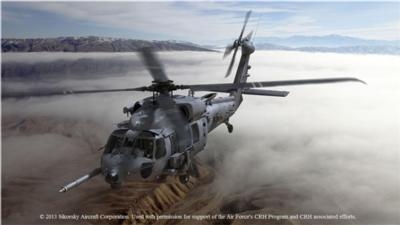Sun, Mar 20, 2016
First U.S. Air Force Platform To Benefit From BAE Systems' Reduced Size Transponder And Common Missile Warning System
The U.S. Air Force has selected BAE Systems to provide critical survivability and situational awareness technology for the U.S. Air Force’s HH-60W Combat Rescue Helicopter. The company will supply its Identification Friend or Foe technology known as the AN/DPX-7 Reduced Size Transponder (RST) and its Common Missile Warning System (CMWS). These contracts mark the first time that a U.S. Air Force platform will benefit from the RST system and from CMWS, a highly automated and tightly integrated infrared countermeasures suite.

“When airmen enter into dangerous situations to rescue wounded soldiers, they require the best technology available to safeguard them during these vital missions and provide them with situational awareness,” said John Watkins, vice president of Business Development at BAE Systems. “By equipping the Combat Rescue Helicopter with RST and CMWS, the Air Force can be confident that its airmen will be using technology that has been proven in theater on multiple U.S. Army and Navy platforms.”
At half the size and weight of others that are fielded, BAE Systems’ transponder is ideal for aircraft such as the Combat Rescue Helicopter, where space must be maximized and weight limited to increase the aircraft’s performance. The transponder is currently on several manned and unmanned aircraft, including the MQ-4C Triton. It also supports combat identification and sense-and-avoid applications with its Mode 5 and ADS-B In/Out capabilities.
The Air Force will deploy the CMWS Gen3 system that includes both hostile fire indication and data recording capabilities to detect and evade small arms fire and rocket-propelled grenades. The system also performs detailed post-mission analysis. CMWS missile warning technology has served more than 24 U.S. Army platform types and has amassed more than 2 million in-theater hours.
These awards to BAE Systems follow the Air Force’s 2014 decision to select the team of Sikorsky and Lockheed Martin to replace the HH-60G Pave Hawk helicopters with a derivative of the Sikorsky Black Hawk. As part of the Air Force’s Combat Search and Rescue Mission, which includes Personnel Recovery Operations, the helicopters are used to extricate troops from dangerous situations in uncertain or hostile environments. Preliminary design review of this new aircraft is expected to take place this year.
(Sikorsky image provided with BAE Systems news release)
More News
How To Get A Story On Aero-TV News/Feature Programming How do I submit a story idea or lead to Aero-TV? If you would like to submit a story idea or lead, please contact Jim Campbel>[...]
Aero Linx: International Association of Professional Gyroplane Training (IAPGT) We are an Association of people who fly, build or regulate Gyroplanes, who have a dream of a single >[...]
NORDO (No Radio) Aircraft that cannot or do not communicate by radio when radio communication is required are referred to as “NORDO.”>[...]
Also: uAvionix AV-Link, F-16 Viper Demo, TN National Guard, 'Staff the Towers' A Saturday afternoon jump run, originating from SkyDive Kansas City, went bad when it was reported th>[...]
Beyond Visual Line Of Sight (BVLOS) The operation of a UAS beyond the visual capability of the flight crew members (i.e., remote pilot in command [RPIC], the person manipulating th>[...]
 ANN FAQ: Contributing To Aero-TV
ANN FAQ: Contributing To Aero-TV ANN's Daily Aero-Linx (05.29.24)
ANN's Daily Aero-Linx (05.29.24) ANN's Daily Aero-Term (05.29.24): NORDO (No Radio)
ANN's Daily Aero-Term (05.29.24): NORDO (No Radio) Airborne 05.28.24: Jump Plane Down, Starship's 4th, Vision Jet Problems
Airborne 05.28.24: Jump Plane Down, Starship's 4th, Vision Jet Problems ANN's Daily Aero-Term (05.30.24): Beyond Visual Line Of Sight (BVLOS)
ANN's Daily Aero-Term (05.30.24): Beyond Visual Line Of Sight (BVLOS)



